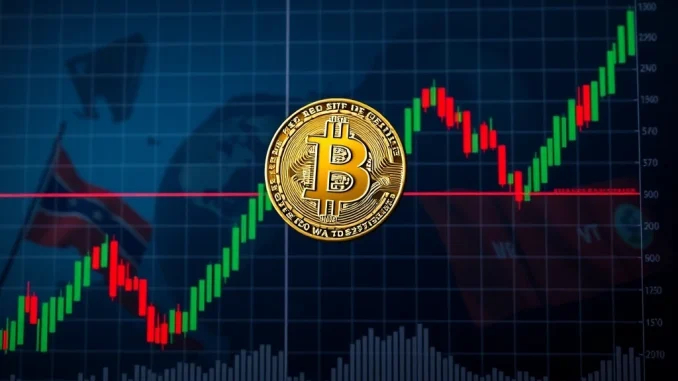
Hold onto your hats, crypto enthusiasts! The Bitcoin rollercoaster just took a sharp dip. After a period of relative stability, Bitcoin (BTC), the king of cryptocurrencies, experienced a notable downturn, sliding from a high of $88,000 to around $82,500. This sudden drop coincided with the announcement of reciprocal tariffs by former U.S. President Donald Trump, sending ripples of concern throughout the crypto market. Currently hovering around $83,300, according to CoinDesk data, BTC’s future trajectory is now under intense scrutiny.
Is a Bearish ‘Death Cross’ Forming for Bitcoin?
Adding fuel to the fire of worry is the looming formation of a bearish ‘death cross’ pattern on Bitcoin’s price charts. This ominous technical indicator occurs when the 50-day simple moving average (SMA) crosses below the 200-day SMA. While the ‘death cross’ isn’t always a foolproof predictor of market downturns, its appearance, especially amidst the current economic uncertainty sparked by Trump Tariffs, is giving many investors pause.
Understanding the Death Cross: A Quick Breakdown
- What it is: A technical chart pattern where a short-term moving average (50-day SMA) crosses below a long-term moving average (200-day SMA).
- What it signifies: Generally interpreted as a bearish signal, suggesting a potential shift from an upward trend to a downward trend.
- Accuracy: Its predictive accuracy is debated, and it’s often considered more of a lagging indicator, confirming a trend change that’s already underway.
- Context is Key: The ‘death cross’ should be analyzed in conjunction with other technical indicators and fundamental factors, like global economic events.
The potential ‘death cross’ formation arrives at a sensitive time, amplifying existing anxieties within the crypto sentiment landscape. But what exactly is driving this negative sentiment, and how worried should we be?
Trump Tariffs and Their Ripple Effect on Crypto
The primary trigger for this recent market unease appears to be the announcement of reciprocal tariffs by Donald Trump. Tariffs, essentially taxes on imported goods, can have significant economic consequences, potentially leading to:
- Increased Inflation: Tariffs can raise the cost of imported goods, which businesses may pass on to consumers, contributing to inflation.
- Trade Wars: Reciprocal tariffs can escalate into trade wars, disrupting global supply chains and dampening economic growth.
- Market Uncertainty: Trade tensions create uncertainty in financial markets, prompting investors to seek safer assets and potentially move away from riskier assets like cryptocurrencies.
For the cryptocurrency market, already known for its volatility, the added layer of macroeconomic uncertainty from Trump Tariffs can be particularly unsettling. Investors often react to such news with caution, leading to sell-offs and price corrections.
China’s Crucial Response and the Yuan Factor
The situation is further complicated by the potential response from China, a major global economic player. Robin Brooks, chief economist at the International Institute of Finance, highlighted this crucial aspect on X (formerly Twitter). He suggests that China’s reaction to U.S. tariffs will be pivotal in determining the broader market impact.
Brooks points out that if China chooses to devalue its currency, the China Yuan, as a countermeasure to U.S. tariffs, it could set off a chain reaction. Currency devaluation makes a country’s exports cheaper and imports more expensive. In this scenario:
- Global Risk-Off Move: A Yuan devaluation could trigger a broader ‘risk-off’ sentiment in global markets. Investors may become more risk-averse and move their capital to perceived safe-haven assets.
- Emerging Markets First: Emerging markets are typically the first to feel the impact of such global economic shifts, often experiencing capital outflows and currency depreciation.
- U.S. Impact Follows: Eventually, the risk-off move could spread to the U.S. markets, impacting various asset classes, including cryptocurrencies.
While China has been notably cautious in its responses so far, the potential for a shift in strategy remains a significant concern for market watchers. The interplay between U.S. trade policy and China’s economic response is now a critical factor influencing market sentiment, and particularly the direction of the crypto market.
Navigating the Uncertainty: What’s Next for Bitcoin?
The current situation presents a complex picture for Bitcoin investors. The confluence of factors – Trump’s tariffs, the potential ‘death cross’, and uncertainty surrounding China’s response – has created a climate of heightened anxiety and bearish crypto sentiment.
Key Takeaways and Actionable Insights:
- Monitor the Death Cross: Keep a close watch on Bitcoin’s price action and the moving averages. If the 50-day SMA decisively crosses below the 200-day SMA, it could signal further downside potential.
- Track Trade War Developments: Stay informed about any escalations or de-escalations in trade tensions between the U.S. and China, as these will directly impact market sentiment.
- Watch the Yuan: Pay attention to any moves by China regarding the Yuan. A significant devaluation could be a red flag for broader market instability.
- Diversify and Manage Risk: In times of uncertainty, portfolio diversification and prudent risk management are crucial. Consider adjusting your crypto exposure based on your risk tolerance.
- Long-Term Perspective: Remember that market corrections are a normal part of the crypto cycle. Focus on the long-term fundamentals of Bitcoin and the broader crypto ecosystem amidst short-term volatility.
Conclusion: Bracing for Potential Headwinds in the Crypto Market
The recent dip in Bitcoin’s price and the looming ‘death cross’ serve as a stark reminder of the interconnectedness of the crypto market with global economic events. Trump’s tariffs and the potential for a Chinese response have introduced a new layer of uncertainty, impacting market sentiment and potentially paving the way for further volatility. While the situation remains fluid, staying informed, managing risk, and maintaining a long-term perspective will be key for navigating these potentially turbulent times in the crypto world. The market is sending a clear plunge alert – be prepared for potential headwinds.



